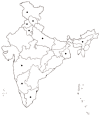Prevalence of COPD in India: a systematic review
- PMID: 22790612
- PMCID: PMC6547954
- DOI: 10.4104/pcrj.2012.00055
Prevalence of COPD in India: a systematic review
Abstract
Background: The increasing burden of chronic diseases is a particular risk to countries with developing health systems. Chronic obstructive pulmonary disease (COPD) is contributing to the burden of chronic diseases. Understanding the current prevalence of COPD in India is important for the production of sustainable management strategies.
Aims: To provide a systematic review of studies assessing the prevalence of COPD in India.
Methods: Database searches, journal hand searches, and scanning of reference lists were used to identify studies. Studies of general adult populations resident in India were included. Data extraction and quality assessment were carried out using pre-tested proformas. Owing to the heterogeneity of reviewed studies, meta-analysis was not appropriate. Thus, narrative methods were used.
Results: We did not identify any studies from which we could draw a rigorous estimate of the prevalence of COPD by standard definition. Reliable standard estimates of chronic bronchitis were only available for rural populations. We identified four studies that gave estimated prevalences between 6.5% and 7.7%, and others suggestive that prevalences in some environmentally atypical regions may lie outside this range. Sex and smoking status were relatively important predictors of COPD prevalence. Residential environs, age, and domestic smoke exposure are also important, but investigation of their effect was limited by study heterogeneity.
Conclusions: Although limited by the number and heterogeneity of studies and their unsuitability for meta-analysis, we found the most rigorous existing estimates of the general prevalence of chronic bronchitis in rural areas to lie between 6.5% and 7.7%. These figures are unlikely to apply to all Indian subpopulations, so the general prevalence of chronic bronchitis in India remains unknown. Accurate estimates of the prevalence of chronic bronchitis/COPD from across the country are required to supplement existing data if optimal management strategies are to be devised.
Conflict of interest statement
The authors declare they have no conflicts of interest in relation to this article.
Figures


Comment in
-
Understanding the true burden of COPD: the epidemiological challenges.Prim Care Respir J. 2012 Sep;21(3):249-51. doi: 10.4104/pcrj.2012.00082. Prim Care Respir J. 2012. PMID: 22885564 Free PMC article. No abstract available.
References
-
- Report of the Secretary General. Prevention and control of non-communicable diseases. Item 119; United Nations 66th session, 2011. Available from: http://www.un.org/ga/search/view_doc.asp?symbol=A/66/83&Lang=E (accessed Dec 2011).
-
- World Health Organization. Global status report on non-communicable diseases 2010. World Health Organization, 2011. Available from: http://www.who.int/nmh/publications/ncd_report_full_en.pdf (accessed Dec 2011
-
- Global Risks 2010: A Global Risk Network Report, World Economic Forum, January 2010. World Economic Forum, 2010
-
- World Health Organization. Chronic obstructive pulmonary disease (COPD) Fact sheet No 315. World Health Organization, 2011. Available from: http://www.who.int/mediacentre/factsheets/fs315/en/index.html (accessed July 2011).
-
- Department of Measurement and Health Information Systems of the Information, Evidence and Research Cluster. World Health Statistics 2008. World Health Organization, 2008. Available from: http://www.who.int/whosis/whostat/EN_WHS08_Full.pdf (accessed Aug 2011).
Publication types
MeSH terms
LinkOut - more resources
Full Text Sources
Medical
